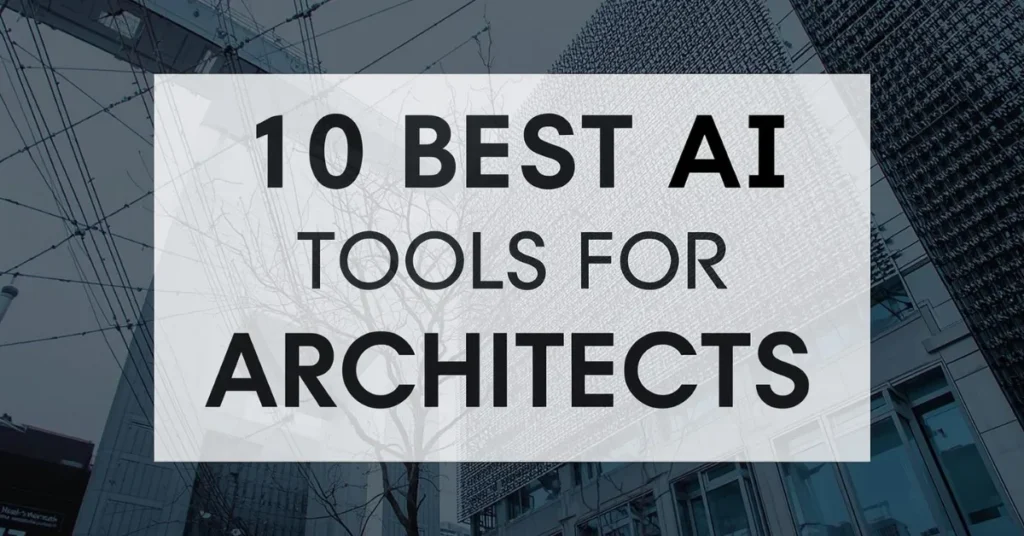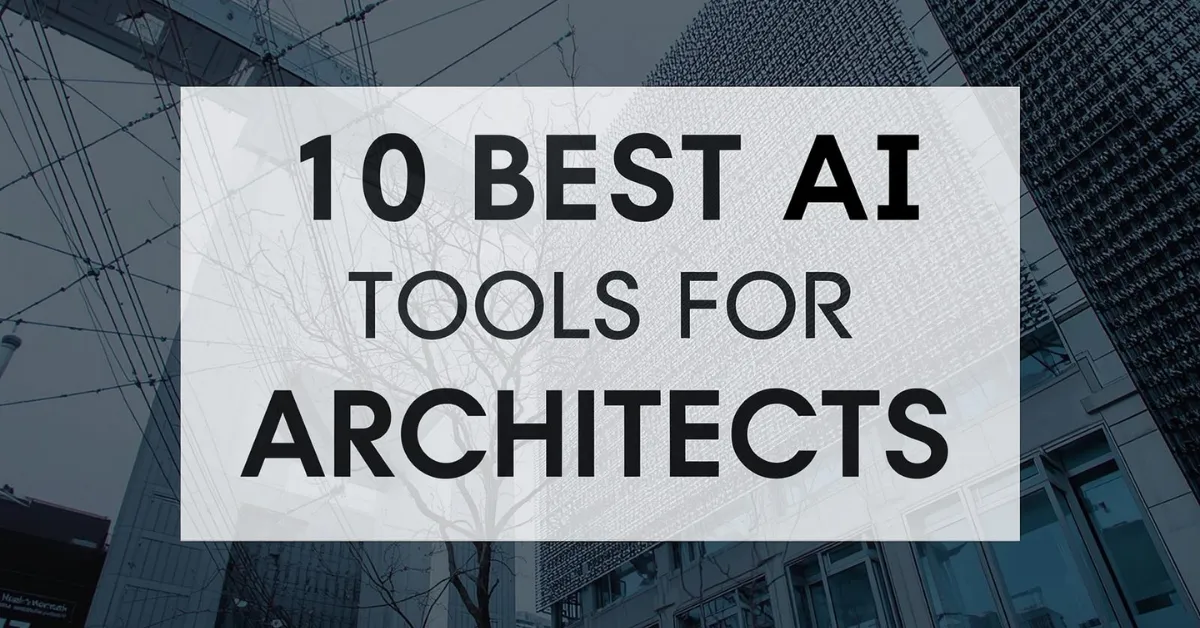The architectural landscape is changing rapidly with the integration of Artificial Intelligence (AI). AI Tools are transforming how designs are conceived, planned, and delivered. AI is no longer an experimental add-on but a vital component that streamlines workflows, enhances design quality, and shortens project timelines.
Whether you’re an experienced architect or a newcomer, embracing AI tools can boost your productivity, creativity, and competitive edge in 2026. This blog Rewarded Feature the 10 best AI tools for architects—both free and paid—including their features, pricing, ideal users, personal insights, and guidance on choosing the best fit.
1. Autodesk Forma (Formerly Spacemaker AI)
Autodesk Forma stands out for its ability to digest complex site data—topography, daylight, noise, zoning—into actionable, optimized massing plans in minutes. This AI-powered tool analyzes various environmental and regulatory constraints to generate site proposals that enhance views, natural light, and acoustic performance.
Prefect For: Early-stage site planning and feasibility studies
Cost: Paid (Free trial available)
Who Can Use It? Architects, urban planners, and developers focused on site feasibility and early schematic design phases.
Personal Experience: Forma’s capacity to deliver evidence-based design alternatives accelerates decision-making and improves stakeholder buy-in, especially during challenging site analyses.
| Feature | Details |
| Prefect For | Early-stage site planning and feasibility studies |
| Pricing (Official) | $185/month OR $1,445/year (approx.) |
| Free Trial | ✅ Available |
| Official Source | Autodesk Forma – Free Trial |
| Rewarded Feature | AI-powered site analysis (daylight, noise, zoning) and real-time design optimization |
| Key Thing to Accept | Ideal for architects and developers focusing on environmental and regulatory design constraints. |
2. TestFit
TestFit automates site feasibility by creating optimized unit mixes and parking layouts based on inputs like lot boundaries and setbacks. This accelerates pre-acquisition due diligence, saving hours that might otherwise be spent on sites unsuitable for development.
Prefect For: Rapid feasibility studies and multi-family site planning
Cost: Paid (Demo available)
Who Can Use It? Residential developers and architects who need quick site validation.
Personal Experience: Using TestFit has reduced decision delays and improved early-stage confidence for multi-family projects.
| Feature | Details |
| Prefect For | Rapid feasibility studies, multifamily, and mixed-use site planning |
| Pricing (Official) | Urban Planner: ~$100/month Data Maps: ~$250/month Site Solver: from ~$8,000/year Enterprise: Custom |
| Free Demo | ✅ Available |
| Official Source | TestFit.io |
| Rewarded Feature | Automates site layouts, parking, and unit mixes for instant site validation. |
| Key Thing to Accept | Great for developers needing to test site viability quickly before acquisition. |
3. Finch 3D
Finch redefines BIM workflows by enabling live parametric adjustments. By setting parameters such as floor area or density targets, architects can watch their designs update in real time, maintaining continuity from concept through detailed design phases.
Prefect For: Live generative design iteration
Cost: Paid (Beta access)
Who Can Use It? Architects and BIM managers using Revit or Rhino.
Personal Experience: Finch’s integration with established BIM platforms has made design tweaks faster, reducing translation errors and expediting approvals.
| Feature | Details |
| Prefect For | Live generative design iteration |
| Pricing (Official) | Free Plan: Available Basic: €49/month (≈ $52) Enterprise: ~€12,000/year (3 seats) |
| Official Source | Finch3D.com |
| Rewarded Feature | Parametric BIM workflow with real-time design updates linked to Revit/Rhino |
| Key Thing to Accept | Perfect for continuous concept-to-design-stage development. |

4. Midjourney
Midjourney generates rich concept visuals from simple text prompts, creating mood boards that evoke the desired atmosphere before detailed modeling begins. It’s perfect for early client engagements and design discussions focused on feelings and ideas.
Prefect For: Ideation and concept visual storytelling
Cost: Paid (Free limited use via Discord)
Who Can Use It? Architects, designers, and visual storytellers looking to rapidly create concept imagery.
Personal Experience: Midjourney has transformed abstract notions into compelling visuals, fostering better dialogue and creative alignment early on.
| Feature | Details |
| Prefect For | Ideation and visual storytelling for concept design |
| Pricing (Official) | Basic: $10/month Standard: $30/month Pro: $60/month Mega: $120/month |
| Platform | Discord |
| Official Source | Midjourney.com |
| Rewarded Feature | Generates concept visuals and mood boards from simple text prompts. |
| Key Thing to Accept | Great for architects to visualize design moods before modeling. |
5. Arkdesign.ai
Arkdesign.ai takes programmatic inputs like bedroom counts and ceiling heights and instantly generates multiple schematic floor plans, enabling architects to overcome blank canvas challenges swiftly.
Prefect For: Generating residential floor plan options
Cost: Free (Beta access)
Who Can Use It? Residential architects and designers need quick layout options.
Personal Experience: Offering several floor plan drafts in meetings has improved client engagement and reduced initial design revisions.
| Feature | Details |
| Prefect For | Generating residential floor plan options |
| Pricing (Official) | Free (Beta Access) |
| Official Source | Arkdesign.ai |
| Rewarded Feature | Auto-generates multiple schematic layouts from programmatic inputs. |
| Key Thing to Accept | Ideal for residential architects and early-stage space planning. |
6. Hypar
Hypar empowers teams to codify and automate common design elements such as stair cores or facades. Hosted in the cloud, it facilitates collaborative parametric design across projects, ensuring consistency and scalability.
Prefect For: Automating repetitive design logic
Cost: Freemium
Who Can Use It? Design teams and offices aiming to standardize and speed up repetitive tasks.
Personal Experience: Implementing Hypar’s cloud-based functions has increased efficiency in multi-project office environments.
| Feature | Details |
| Prefect For | Automating repetitive design logic and cloud-based collaboration |
| Pricing (Official) | Free Plan: Available Individual/Pro: ~$25/month Enterprise: Custom |
| Official Source | Hypar.io |
| Rewarded Feature | Allows teams to create reusable parametric logic (e.g., cores, facades). |
| Key Thing to Accept | Excellent for firms standardizing design processes across multiple projects. |
7. ArchiGAN
ArchiGAN utilizes AI to quickly morph simple building models into varied facade designs, allowing rapid exploration of aesthetics without full render workflows.
Prefect For: Photo-realistic façade transformations
Cost: Free (Research tool)
Who Can Use It? Architects and facade designers are experimenting with style alternatives.
Personal Experience: ArchiGAN’s innovative approach invites more creative facade options without lengthy visualization bottlenecks.
| Feature | Details |
| Prefect For | Photo-realistic transformations and concept exploration |
| Pricing (Official) | Free (Research-based tool) |
| Official Source | ArchiGAN GitHub (or academic repositories) |
| Rewarded Feature | AI morphs simple models into detailed façade concepts instantly. |
| Key Thing to Accept | Great for academic or experimental use; not a commercial product yet. |
8. Delve by Sidewalk Labs (Google)
Delve helps urban designers balance complex goals like walkability and sustainability by generating ranked design scenarios rooted in real-world data.
Prefect For: Urban design and infrastructure trade-offs
Cost: Enterprise (Custom pricing)
Who Can Use It? City planners, urban designers, and infrastructure developers.
Personal Experience: Delve has proven valuable in public sector projects needing data-backed scenario comparisons.
| Feature | Details |
| Prefect For | Urban design, sustainability, and infrastructure optimization |
| Pricing (Official) | Enterprise Pricing (Custom Quote Only) |
| Official Source | Sidewalk Labs – Delve |
| Rewarded Feature | AI-driven analysis for balancing walkability, density, and environmental impact. |
| Key Thing to Accept | Ideal for city planners and infrastructure developers. |
9. LookX.ai
LookX.ai generates diverse interior design variations from existing plans or photos, speeding concept prototyping and client presentations.
Prefect For: Interior design concepts and space visualization
Cost: Freemium with paid tiers
Who Can Use It? Interior designers and architects are managing fit-outs and renovations.
Personal Experience: The tool’s quick visualization of furniture layout and aesthetics enhances client approvals and creative exploration.
| Prefect For | Interior design visualization and fast concept prototyping |
| Pricing (Official) | Free: 100 X-PointsMonthly: $20/monthAnnual: $199/year |
| Official Source | LookX.ai Pricing |
| Rewarded Feature | Generates multiple interior design variations from sketches or photos. |
| Key Thing to Accept | Excellent for interior designers and fit-out architects. |
10. Revit Copilot
Revit Copilot automates tedious Revit tasks like sheet generation, room naming, and clash detection, embedding office standards and project-specific rules into AI-driven workflows.
Prefect For: Workflow automation within Revit
Cost: Varies based on add-in
Who Can Use It? BIM managers and architects invested in Revit workflow optimization.
Personal Experience: Copilot has minimized repetitive inputs and kept models organized, allowing focus on high-value design work.
| Feature | Details |
| Prefect For | Workflow automation within Revit |
| Pricing (Official) | Varies (add-in-based licensing; no fixed public rate) |
| Official Source | Autodesk App Store |
| Rewarded Feature | Automates tasks like room naming, sheet creation, and clash detection. |
| Key Thing to Accept | A time-saving plug-in, especially for BIM managers and Revit-heavy workflows. |
How to Choose the Best AI Tool for Your Architecture Practice?
Selecting the right AI tool for an architect depends on your project type, workflow stage, and budget.
Here’s a simplified guide that can be helpful for you in choosing the right tools
- For Site and Feasibility Work: Autodesk Forma, TestFit, and Finch excel at translating site data and design parameters into actionable options.
- For Concept and Visuals: Midjourney and ArchiGAN aid storytelling and facade exploration.
- For Repetitive and Parametric Logic: Hypar and Revit Copilot reduce manual work, enhancing consistency.
- For Residential Design: Arkdesign.ai quickly generates floor plan options.
- For Urban and Infrastructure Projects: Delve offers robust scenario modeling.
- For Interiors: LookX.ai speeds concept visualization.
Conclusion
AI tools for architects are not about replacing human creativity; they’re about expanding your bandwidth to focus on what matters most. Embracing these AI tools for architects—whether it’s quick feasibility checks, dynamic modeling, or compelling visuals- accelerates workflows and improves design outcomes. Integrate one today and watch your architectural practice thrive in 2026 and beyond.
What are AI tools used for in architecture?
AI tools in architecture help automate design generation, site analysis, visualization, and workflow management—saving time while improving design accuracy and creativity.
Which AI tool is perfect for building design visualization?
Tools like Midjourney and LookX.ai are excellent for creating concept visuals, mood boards, and interior renderings.
Are there any free AI tools for architects?
Yes — ArchiGAN, Arkdesign.ai, and the free plans of Hypar and LookX.ai offer solid capabilities for beginners or small studios.
Can AI replace architects in the future?
No. AI assists architects by automating repetitive tasks and generating ideas, but creative and contextual decision-making still requires human expertise.
Which AI tool is perfect for early-stage site planning?
Autodesk Forma and TestFit are top choices for analyzing site feasibility, massing, and environmental performance in the concept phase.
